-1000.jpg)
Mark Leckey. PS1 performance image.
by VERONICA SIMPSON
Mark Leckey (b1964, Birkenhead) felt he grew up on the wrong side of Liverpool: Ellesmere Port was on the opposite side of the Mersey river, an edgeland of dwindling and dying industry. No wonder articulating life on the edge of things has always appealed to him. His work has often focused on cultural behaviours, identities, totems and places that are marginalised, overlooked and under-celebrated. But it is his passion and affection for this marginalised stuff that fuels him, and that alters and enriches the viewer’s perception.
In the 13 years since Leckey won the ultimate UK art world accolade, the Turner Prize, for his show Industrial Light & Magic (2008), he has enjoyed major recognition, including solo shows at the National Gallery of Denmark (2017), the Museum of Modern Art PS1, New York (2016) and the Wiels Contemporary Art Centre, Brussels (2014). But success in art world terms came after a long period of searching and struggle. Having completed his BA at Newcastle Polytechnic in 1990, he dropped out of the art scene until his showing of Fiorucci Made Me Hardcore (1999) at the Institute of Contemporary Arts (ICA) in London put him in the spotlight. Leckey is still preoccupied with that terrain so rarely addressed, never mind celebrated, in contemporary art – working-class culture. He foregrounds particular moments and memes in music, fashion, film, TV and furniture – carpets and fridges feature – in sculpture, sound and installations, but most powerfully through film, which he manipulates as if it were truly a malleable material.
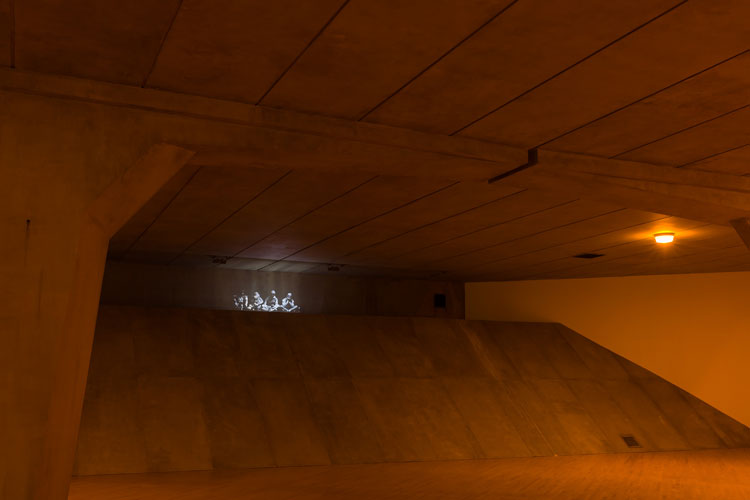
Mark Leckey. Under Under In, 2019. Audio and video installation. Overall display dimensions and duration variable. Installation view, O’ Magic Power of Bleakness, Tate Britain, London, 24 September - 5 January 2020.
For his 2019 solo show at Tate Britain, O’ Magic Power of Bleakness, he constructed a life-size replica of a motorway flyover in the main exhibition hall. Here, he broadcast two earlier films, Fiorucci and the semi-autobiographical Dream English Kid 1964-99 AD (2015), and a new work, Under Under In (2019). The show unfolded over the space of an hour as a multiscreen installation and audio play with video projections, the latter relating a tale of everyday teenagers loitering and bantering, where they think nobody can see them, and, ultimately, escaping from the threat of police intervention by scuttling, crab-wise to safety – in effect turning themselves into physical bridges.
Bridges are a recurring motif in many respects. Leckey’s work is often bridging the gap between analogue and digital, or blurring the terrain between real life and our internet-assisted lives. He has also been successful in bridging the gap with audiences, both generationally (appealing to those who may have experienced the acid house and rave parties he references, as well as those who get their cultural kicks on YouTube) and demographically.
.jpg)
Mark Leckey. Under Armour in the Twilight Sparkle, (film still). Image courtesy Art Night.
For Art Night, which is currently running all over the UK, Leckey has made a new work, Under Armour in the Twilight Sparkle. Veronica Simpson interviewed him in person for Studio International at Somerset House.
Veronica Simpson: You are a highly regarded, Turner prize-winning artist, so I was surprised when my research threw up some candid interviews on how difficult and conflicted your early career was.
Mark Leckey: The only reason I became an artist is because I met this guy, [New York gallerist] Gavin Brown, in New York. If I hadn’t met him, it would never have happened.
VS: I read that it was in New York that someone suggested you make a music video, and from that your Fiorucci piece was born.
ML: It was Emma Dexter, who used to be at the ICA. Gavin ran a gallery and Emma was over in New York and because everyone was into music videos - they were getting really clever, mid-90s - that’s what I wanted to do, too: make music videos. I lived in San Francisco for a bit, worked in this place called Artists’ Television Access, and did a bit of programming there. At that time, you used to get these VHS tapes, compilation tapes, passed around like pirate copies, all sorts of different videos. I had been collecting them. I was working on a piece that was originally going to be called Moments in Love. I was looking for recorded pieces of video of performances that were very intense, powerful, strange. I started putting them together and it was quite boring. It didn’t really translate.

Mark Leckey. Fiorucci Made Me Hardcore, 1999. Video, projection, colour and sound, overall display dimensions variable, duration: 15 min. Installation view, O’ Magic Power of Bleakness, Tate Britain, London, 24 September - 5 January 2020.
VS: It is interesting viewing the finished film again: it seems you brought added intensity by stripping out the music. For example, in some of those northern soul dance hall scenes, there is incredible energy, a collective kind of choreography going on, but you can’t hear what they are dancing to. It is mesmerising in part because you can’t hear the music.
ML: That’s not me, that’s the original footage. That northern soul stuff at the beginning is taken from a very odd documentary, from about 1975, by a guy called Tony Palmer, who was trying to make this association between northern soul and the post-industrial landscape of these original mining and weaving communities, the working-class communities. Sometimes they were dancing to folk songs, old folk songs, but sometimes I didn’t really know what they were dancing to, because there was a voiceover. It wasn’t like I could go on YouTube and find the original.
When I was making it, at the end of the 90s, there were a lot of talking-heads-style TV programmes that were nostalgic about the end of pop, and I grew to hate that format. This wasn’t what I wanted to do, so I tried to use something contrary to that. Part of the thing of making Fiorucci is that I really struggled with it. I didn’t have any deadlines. It took me three years to make. I went through all these different attempts and what I learned in making it is that it’s good to get to a point where something fails. I would never say as a piece of advice to someone, “failure is good”, but I would get to the point with something and think: “This just isn’t working.” I’d have a complete panic attack and get very anxious about it and would just have to find a way around it. My favourite bit in it is where someone is dancing and they have a bird tattooed on their arm and it comes off. Basically, because I had all this disparate footage, I was always trying to find a way to bridge the footage, to get from one (clip) to the other, and I remember being really stuck there. And I thought: “Why don’t I try this stupid idea – like the bird just flies to someone else?” I still love it when you do something and you laugh out loud - it comes out like a kind of bark - because it delights you. Then the second feeling is: “No, that’s too ridiculous, I can’t do that.” But I left that one in, and now that’s my favourite bit.
VS: How did you make the bird look as if it is flying away?
ML: It’s very bad animation. It was in [Adobe] After Effects. I mean, I’ve said this before, but the reason I could make Fiorucci is because, at that time, desktop video editing became domestic. I was on a PC - Apple was still prohibitively expensive – and, basically, you could digitise analogue videos. Up until then, the mid-90s, you’d have had to go to some lab and get them to do it and it would be really expensive. The first time these tools became available at home, I learned how to video edit. So, it was a bit of After Effects.
VS: Now this film is part of why you have a huge and youthful fanbase on YouTube. But is that quite a recent audience?
ML: The film disappeared for a long time. It got shown at the ICA, in a group show called Crash!, curated by Scott King, in 1999. And I got gallery representation from that show, which was good. But I was lucky because (that kind of success) was very slow for me. There are all these things in play now that were not in play at that time. There were not many commercial galleries, and definitely not that many places that showed video.
VS: You had time to build up a practice.
ML: Yes. I did Fiorucci and, that first time I showed it, I literally got hoisted on people’s shoulders, everyone was slapping me on the back going: “Great work.” Then I made the next piece and nothing happened. So, I went, OK. The interesting thing about this is, and it relates particularly to northern soul: the reason that looks so peculiar now is because it was left to its own devices: it was a scene that was happening in a part of England that no music journalist ever went to. It created its own ecology. And I had the equivalent, in that I had a chance to make work without any real pressure, essentially. Which I think you would feel now, especially if you made something that everyone immediately liked. It’s harder - more like the music business. I’m quite thankful about that.
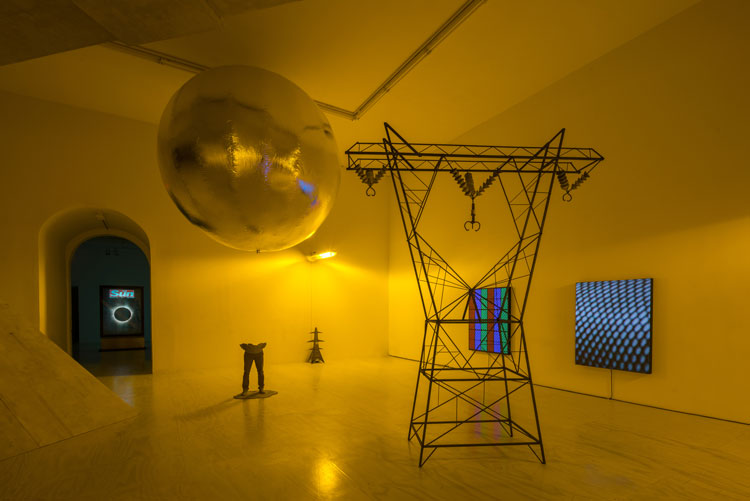
Mark Leckey. Containers and Their Drivers, installation view, MOMA PS1, New York, 23 October 2016 - 5 March 2017. Photo: Pablo Enriquez. Image courtesy the Artist and Cabinet, London.
VS: But you had shown at New Contemporaries before.
ML: That was when I was at Newcastle. That was disastrous. I didn’t make any work when I was at Newcastle. When I went there, I wanted to be a muralist. I wanted to make political murals, initially. And as soon as I got there that just felt really naive. Then all this critical theory came in and I started reading about the Situationists and (Guy Debord’s) The Society of the Spectacle. Then I made this piece and Rachel Whiteread came up and did a tutorial and encouraged me to put it in - I was grateful to her for that. It went into the ICA and was bought by Doris Saatchi. I went back to Newcastle thinking I was the bee’s knees. Then I did a disastrous degree show, because I was too cocky and self-important. It was really bad for me.
VS: You came to London though.
ML: I came to London, but not thinking I could be an artist. I tried to do lots of things, sold clothes in Portobello Market. That went all right for a while, then it didn’t. I just didn’t have a good time. It got to the point where I was really struggling, quite miserable, washing dishes. I thought: “I’ve had enough of this.”
Then I went to New York and the opposite happened – I had an amazing time, everything was happening there.
VS: What brought you back to the UK?
ML: I got homesick. I missed my family. I like New York a lot, but I had come back with a good skillset. I had learned HTML in the early days of the web, and I came back and became a freelance web designer, which at that time was paying really well. So, it was a lot different. Then everyone started to catch up with me. It was harder to get work. I ended up working full time for a company, and really hated it. That’s when I started making Fiorucci. I worked for a place called Online Magic. I’d work there in the day and then I’d edit at night.
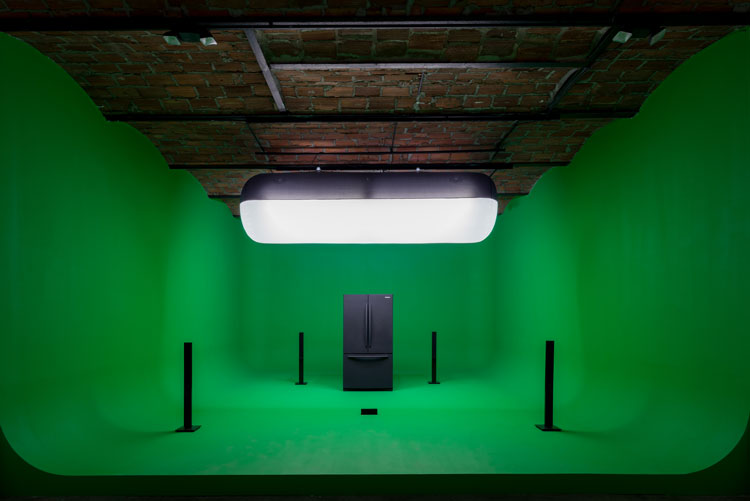
Mark Leckey. Containers and Their Drivers, installation view, MOMA PS1, New York, 23 October 2016 - 5 March 2017. Photo: Pablo Enriquez. Image courtesy the Artist and Cabinet, London.
VS: I’m surprised in some ways that you didn’t end up doing music videos.
ML: It never happened. It’s like I got the chance to be an artist instead, I kind of fell into that scene. I didn’t know anyone in the music video scene. It’s who you know, and I didn’t have any connections in that world. The only reason I met Gavin was because he’d gone to Newcastle as well. That’s how we got to meet.
VS: There was a great quote in one of your interviews, where you said you are “continually doubting art’s place in the world”, whereas you can believe in music completely. Do you think that’s because music places you firmly in the here and now? You know that it is grounding you in this three or five-minute space, as long as the tune will last. It’s visceral. Art can be all that, but also really ephemeral, intellectually and emotionally porous.
ML: I don’t know. I couldn’t set one against the other. At the moment, I’m trying to move more towards music, away from art in some ways. I find the art world so hard to negotiate. There are just so many compromises and conflicts.
There’s a desire at the moment to move towards art as more community based, more like social practice. But art always has this difficulty that, in order to do that, to make itself democratic, it has to make itself accessible. What I like about music is that music can be very community based – very local community – and at the same time be completely avant garde and difficult and really strange. It can do both those things. That’s the problem I have with art. It never resolves itself in the way I want it to. One of the reasons I made Fiorucci was to say: this (working-class) culture is as intelligent, as valuable, as anything in the art world. This is as significant. This is as contemporary, right? It’s an argument essentially about class. This is a culture that develops on its own, outside these institutions. And essentially these institutions always remain bourgeois. I made that video 20 years ago and nothing has changed. Not really. That’s always my frustration with it. I just find that, as an artist, once you enter into these institutions you are directed in a certain way, directed towards a certain kind of exemplary figure of individual greatness.
VS: The artist as hero.
ML: Yeah.
VS: That is problematic in many ways.
ML: Yeah. Neither do I want that, nor do I want to endorse it.

Left: Mark Leckey, Dream English Kid, 1964-1999 AD 2015. Centre: Mark Leckey, As yet untitled, 2019. Right: Mark Leckey, Fiorucci / Dream English Kid / Under under in 2019. Installation view, O’ Magic Power of Bleakness, Tate Britain, London, 24 September - 5 January 2020.
VS: I have always wanted to ask, though, when something major happens – such as winning a national award or being given a solo show at the Tate – it looks like a massive life event, on paper. But does it feel like that to you at the time? Is there a noticeable increase in opportunities or interest?
ML: Not immediately. It’s slow. When you look back, yeah. I mean, the Turner prize definitely made a huge difference. The way it’s experienced is: you get offered a show, something comes up, you’re initially excited, then you start to become nervous, anxious. Then you begin to make the work. You’re organising a lot for a while and you feel like a production manager. I work closely with friends who help me make things. Then there’s a point where I start to edit, and then I just get completely lost. There’s a quote by Blake I’ve used before: “I get lost in the paradise of the work.” That’s what it’s all about. I wake up, and I’m making this thing. There will be some frustrations. And when it comes to the actual event itself, I like it. I enjoy it.
VS: Do you enjoy the attention?
ML: I guess so. I get to see a lot of people I haven’t seen for a long time, because I can be quite solitary. And, yeah, I don’t know about attention, but I like being celebrated. It’s like a birthday. But I don’t work towards that. It’s a lovely thing to have. It’s a joyful thing and I don’t get stressed out, I make sure I’m not stressed out because I want to enjoy it, to savour it. I’ve got a quote I like [from the psychoanalyst Donald Woods Winnicott]: “Artists are people driven by the tension between the desire to communicate and the desire to hide.” That’s nice. Because you hide yourself in the work.
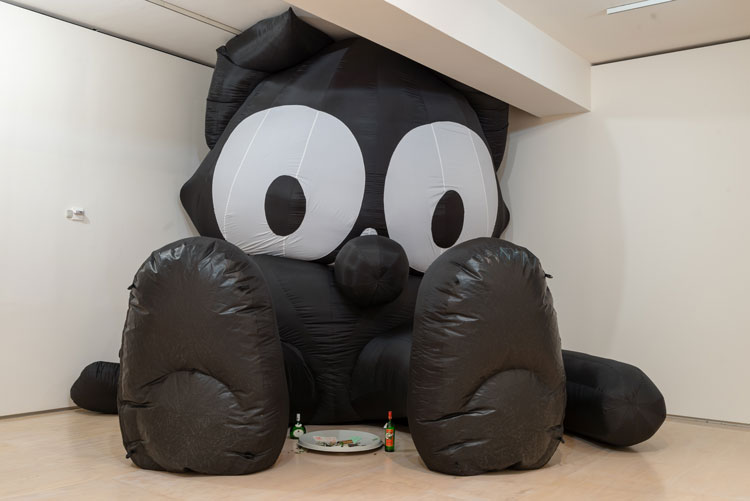
Mark Leckey. Containers and Their Drivers, installation view, MOMA PS1, New York, 23 October 2016 - 5 March 2017. Photo: Pablo Enriquez. Image courtesy the Artist and Cabinet, London.
VS: Can I ask about your process, and whether it has changed? Obviously, you have different tools now. But there is still this wonderful analogue feel of pixelated, granular, blurry-round-the-edges footage. Would you say you are more analogue than digital?
ML: I like both. I work with a guy called Tim, a friend of mine, who does all the CGI stuff. What consumes the most time and expense is making it dirty so it looks realistic. It’s very easy to render this room really quickly, but to make it look lived in takes time. You’re always in that play between the two. A lot of the stuff that I’ve done recently that looks analogue is actually CGI. To me, it’s all kind of like plastic. I used to try and think of it in terms of sculpture. But I don’t believe that any more. I don’t think it is sculptural. It’s a digital space.
VS: But what your work is good at is getting that layered, emotional, physical response to a digital experience.
ML: Yeah … but. I do a radio show on NTS, which has made me listen to a lot more contemporary music and, essentially, every month I go out and find new stuff. There’s this thing now where people are using their voice in a particular and confusing way, doing it both vocally but putting it through digital software so you get these very strange voices. You listen to it and realise they are impersonating the internet. That’s what they’re doing. They are inhabiting it. It’s a sort of psychedelic aspect of what the internet does to us. There’s this strange new limitless and elastic space that we are now inhabiting on a daily basis and we’re yet to kind of acknowledge that is where we actually live now in a very real way.
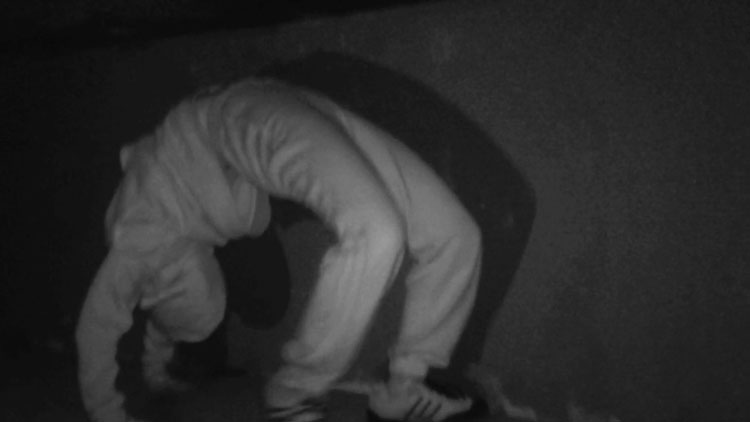
Mark Leckey. O’ Magic Power of Bleakness: Under Under In, 2020. Projection, Digital film, colour, sound, 16 mins 22 secs. https://vimeo.com/429593209
When I think of it like that, to think of it as sculpture seems quite arcane and uninteresting. Trying to impersonate a system is much more interesting. Then I think, that’s what artists have always done and musicians: impersonate the system you’re within. You’re trying to mimic the world as it’s taking place.
I think that it’s psychedelic, rather than sculptural. You’re tricking the brain into making the body respond, so the body thinks it’s feeling it viscerally, but it’s there (taps his head) because you have done something to the head.
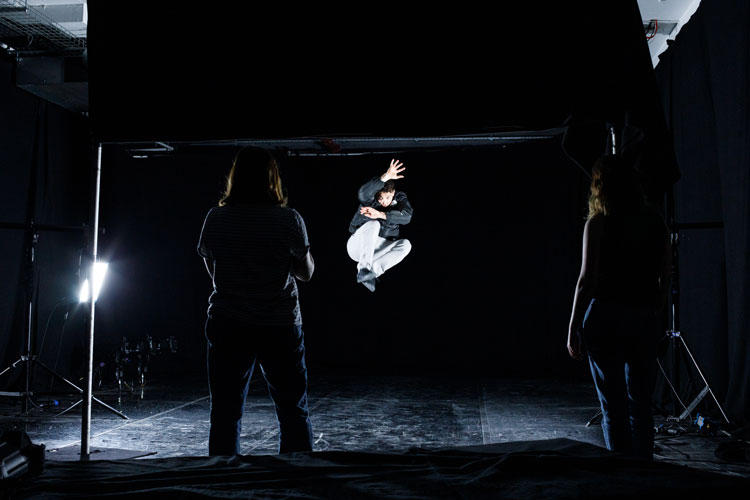
Mark Leckey, 2021. Image courtesy Art Night. Photo: Talie Eigeland.
VS: The next thing coming up is a piece you are doing for Art Night – an event that is usually just in London, but this year is happening all over the UK, and for a whole month, most of it outdoors or online. I’ve read that it uses YouTube footage of a youth crashing through a pane of glass at a bus stop and an acrobat mimicking his movements. Is there more you can tell us?
ML: It’s got those elements in it. It’s a clip I found of this kid just running up to a bus stop and jumping through the glass. There is a lot of stuff like it on the internet, people getting hurt. But there is something tragic and also magnificent about the way he does it. And I’m drawn to that. What’s so compelling about it is that I want to know why. Also, the glass makes a fantastic noise. We talked about CGI, and one of my favourite tricks is to shoot stuff myself and mix it together (with found stuff) so it’s hard to tell.
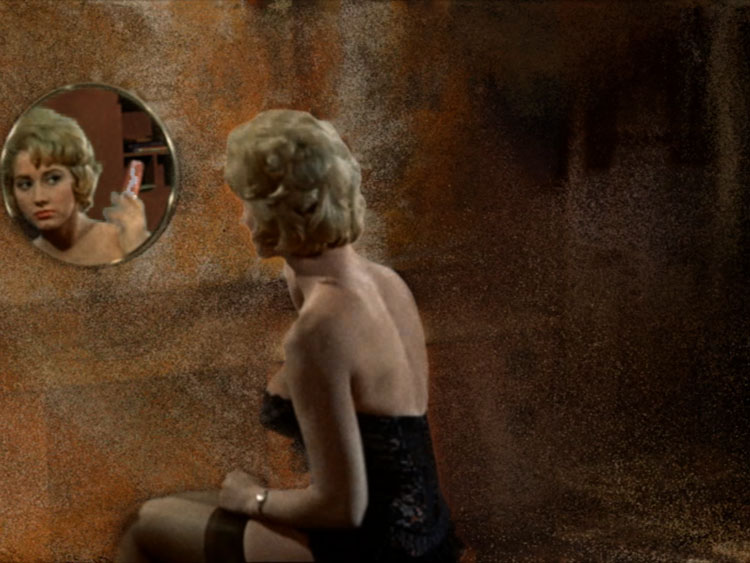
Mark Leckey. Dream English Kid, 1964-1999 AD, 2015. 4:3 film, 5.1 surround sound, 23 mins. A Mark Leckey film in association with Film London Artists’ Moving Image Network and Arts Council England. Image courtesy the Artist and Cabinet, London.
You’ve seen my Dream English Kid film. I take a clip of Liz Fraser from the Carry On film Carry on Cruising and then I got an actor to dress like that and I zoomed in on stuff and mixed it up. I like doing that because I think it confounds you.
VS: It feels as if you are diving into the film?
ML: It’s playing with this sensation that began with Fiorucci: as I was editing and making that video, I had this very intense sense that I wanted to be in the film with them, I wanted to inhabit the same space they did. With this new piece at the moment, what I’m thinking is I’m trying to inhabit them in such a way that they’re almost like a surrogate and I’m trying to place myself inside. I’m trying to think myself into being him in that moment as he smashes through the bus stop. One of the reasons I was attracted to (that clip) was that I did stupid stuff like that as a kid. And usually we were all right. I think he was OK. It’s this idea of imagining myself occupying that moment as he goes through. But I don’t want to overthink it. The work I enjoy the most is work that is conflicted or contradictory; the question I want to come away from art with is: “Why?” Why did that do what it did to me, why did it affect me so much and why would you want to try and hook these things together? What was the drive there? That’s the thing that excites me.
• Art Night is now on across the UK and runs until 18 July 2021, outdoors and online.